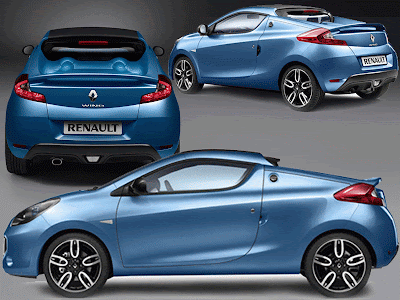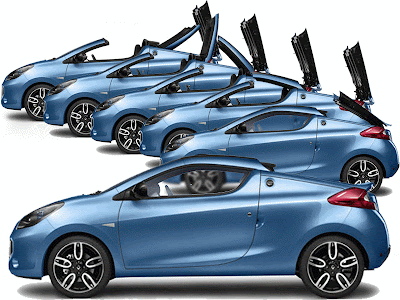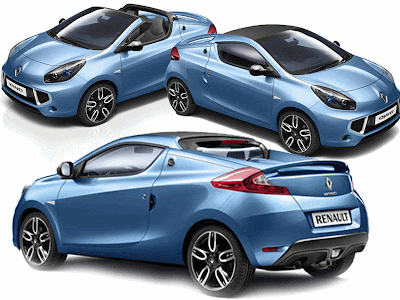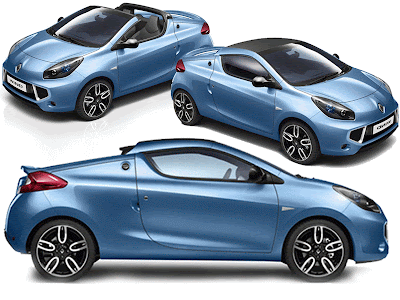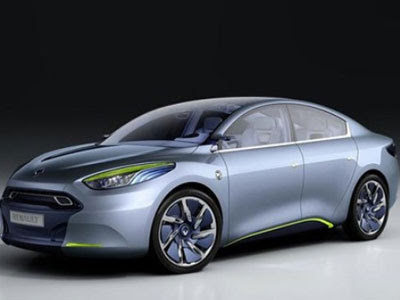Showing posts with label Renault. Show all posts
Showing posts with label Renault. Show all posts
Through much of the last decade, Renault's product lineup lived up to the long-standing French reputation for peculiar design. This was particularly true of its flagship model, the bizarre looking five-door hatchback Vel Satis. That unsuccessful model is now set to be replaced by a much more conventional looking four-door sedan dubbed the Latitude. The Latitude is built on a stretched version of the mid-sized Laguna platform and shares its powertrain options, including the new 3.0-liter diesel V6.
The Latitude is based on the Renault Group’s 2010 Samsung SM5 sedan — which itself is based on the Renault Laguna — that recently went on sale in South Korea. Renault has today provided the first glimpse of its latest international status-enhancing family saloon, Renault Latitude. The Renault Latitude will replace the discontinued and controversial Vel Satis hatchback. Tailored to meet the demand of its different markets, Renault Latitude's specification will deliver the car's different customers a truly high-end package that will position it as the spearhead of international Renault's saloon car range. It will be shown at the forthcoming Moscow Motor Show, Russia, and is due to go on sale this autumn in Asia, Africa, Russia, Turkey, Gulf, Australia and Mexico.
European version of Renault Latitude will be one of the principal new attractions of the 2010 Paris Motor Show where visitors will get a chance to examine its interior design, while full details of the model’s equipment lists and engines ranges will also be released. The international media will be invited to road test Renault Latitude before the end of 2010, and sales will begin shortly afterwards. The contours of the grille are flanked by distinctive bi-Xenon adaptive directional headlights, while chrome embellishments contribute to the unmistakable impression of dynamism and status exuded by the car's overall lines. Its rear-end forms point to ample boot space, and the new car can effectively claim one of the biggest boots in its class. The rear lighting signature employs LED technology and harmonizes perfectly with the chrome rear strip which carries the new model's name: Renault Latitude.
Based on the same architecture as New SM5, which was recently launched in the Korean market, Renault Latitude profits extensively from Renault's engineering expertise. Occupants benefit from a comfortable, silent ride, as well as a particularly precise chassis and a choice of powerplants that are sure to give it a decisive edge over its rivals. The complete equipment list, which will be revealed at a later date, places the emphasis on innovation and travelling comfort, including a dual-mode air ionizer with double fragrance diffuser, triple-zone climate control, a massaging driver's seat, Bose Premium audio, the Renault hands-free card, etc.
Renault Electric Sports Car DeZir Concept
The Renault DeZir project is the first to have been led by Laurens van den Acker and marks the start of a sequence of concept cars that will provide an insight into Renault Design's new vision for the future. DeZir stands out as an illustration of the brand's commitment to more emotional styling.
The DeZir is a two-seater coupé that Renault says stands out as an illustration of the company’s commitment to more emotional styling. With its sports car looks and ability to accelerate from 0 to 100 km/h (62mph) in five seconds, or 0 to 50 km/h in just two seconds, it’s hard to disagree.

Although the DeZir is purely a concept car at this point, Renault is strongly hinting that it shows not only the direction they plan on heading with sports cars in the future, but that it is indicative of a new overarching design and styling philosophy across the entire Renault brand.
The 'Z' in the name Renault DeZir is a direct reference to Renault's Z.E. signature, and several features of its design are suggestive of two qualities readily associated with electric mobility, namely advanced technology and light weight.

DeZir is powered by an electric motor mounted in a mid-rear position to optimize weight distribution over the front and rear wheels. The vertically-mounted 24kW/h lithium-ion battery is located behind the benchseat and provides the car with a range of 160km.
Battery cooling is ensured not only by the air channelled from the front to the back of the car, but also – and above all – by the flow of air that enters through the lateral scoops concealed behind the aluminium panels on either side of the body.

Employing the same principles as the KERS (Kinetic Energy Recovery System) seen in Formula 1, when the car decelerates, kinetic energy is recovered and stored in the battery. This energy can then be employed by the driver to provide a temporary power boost using a button located on the steering wheel. The car can be charged in 8 hours at 240-v, can get to 80% charge in 20 minutes at 4o0-v (3-phase) and will accept battery swapping made possible by the Better Place alliance.

The basic motor is the same as the unit used for Renault's production electric cars, although an evolution has enabled its power and torque to be uprated to 110kW (150ch) and 226Nm respectively. Through the extensive use of lightweight materials such as the Kevlar body, the DeZir tips the scales at just 830kg or 1,830 pounds. According to the French carmaker, the DeZir can go from zero to 100km/h (62mph) in 5 seconds and reach a top speed of 180km/h or 112mph.

The DeZir will debut in October at this year's Paris Motor Show, but no date has been set for its full release. According to Fast Company, by the end of 2013 the Renault-Nissan alliance hopes to produce 500,000 electric vehicles globally, including the 2011 Fluence ZE and the 2011 Kangoo ZE electric van.
Labels: Concept Car, Renault, Sports Car
2011 Renault Wind Sport coupe-roadster
Renault announced its plans to unveil the brand-new Wind coupe-roadster at the upcoming Geneva Motor Show 2010 on 2 March. The 2011 Renault Wind is designed for two persons. Despite the fact that Renault pitches the car as a coupe-roadster, unlike other CC models with retractable hardtops, the Wind uses an exclusively innovative electric roof that rotates 180 degrees into the trunk, which is capable to open in just 12 seconds.
2011 Renault Wind Sport coupe-roadster
Renault Wind brings a completely different take on a car for drivers who enjoy wind-in-the-hair motoring. Renault Wind is aimed at motorists who lust after a car that is not only distinctive and compact, but also convertible yet practical enough for everyday use.
2011 Renault Wind Sport coupe-roadster
Advantages of this car is the only car of its class to provide just as much luggage space (270dm3 VDA) whatever the position of the roof. The Renault Wind has a 3.83 metres in length which features a highly innovative way of opening up. The strictly two-seater model shares its platform and mechanical hardware with the Twingo, though at 3.830mm long, it's 230mm longer than the hatchback.
2011 Renault Wind Sport coupe-roadster
The French automaker is keeping a tight lid on other details for now, but it is expected that the Wind will be offered with two of the Twingo's petrol engines, a 1.2-liter turbo with 100HP and a naturally aspirated 1.6-liter unit with 133HP.
2011 Renault Wind Sport coupe-roadster
Although Renault Wind’s compact dimensions make it a nimble machine in and about town, it is the only car of its class to provide just as much luggage space (270dm3 VDA) whatever the position of the roof. True to Renault's brand signature "Drive the Change", Wind makes passion affordable for everyone.
2011 Renault Wind Sport coupe-roadster
Labels: 2011, Coupe, Renault, Roadster, Sports Car
Renault introduced at the Frankfurt Auto Show, four electric vehicle concept, of which the closest to mass production Fluence ZE model.
Budget Fluence sedan got a new design, 95-hp electric motor and battery lithium-ion batteries, which is enough for 160 kilometers. Charge can be within 4-8 hours, the fastest way for 20 minutes or be replaced by a charged battery on a special stand for 3 minutes.
Electric car plan to release to the markets of Europe and Israel in 2011, when the lithium-ion batteries will become available and the Government will develop a discount program for the purchase of electric vehicles.
Labels: Concept Car, Electric Car, Renault, Sport Car

The 2009 Megane Trophy will go on sale at the end of the year in the form of kit after the completion of its development programme which will enable existing cars to be upgraded.
The 2009 Renault Megane Trophy is based on the new Megane Coupe which is powered by the Renault-Nissan Alliance’s mid-rear 3.5-liter V6 24V engine that produces 360 hp.
The front and rear light units and windscreen are from the Megane Coupe road car while flowing lines of the bodywork was designed from digital simulation technology to improve the aerodynamic.
The Renault Megane Trophy features front splitter which channel air flow to the extractors and rear diffuser and wing that generated downforce. Downforce has improved by 20 % with the refinements to the set-up and drag was reduced by 15 % , which together, represent a gain of almost 40% in terms of the new car’s aerodynamic performance over the previous generation vehicle.
The 2009 Renault Megane Trophy is based on the new Megane Coupe which is powered by the Renault-Nissan Alliance’s mid-rear 3.5-liter V6 24V engine that produces 360 hp.
The front and rear light units and windscreen are from the Megane Coupe road car while flowing lines of the bodywork was designed from digital simulation technology to improve the aerodynamic.
The Renault Megane Trophy features front splitter which channel air flow to the extractors and rear diffuser and wing that generated downforce. Downforce has improved by 20 % with the refinements to the set-up and drag was reduced by 15 % , which together, represent a gain of almost 40% in terms of the new car’s aerodynamic performance over the previous generation vehicle.
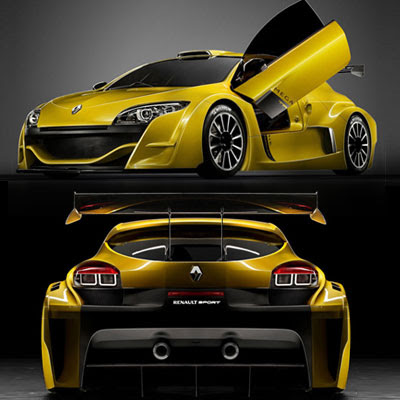
Apart from that, the Megane Trophy also features butterfly doors reminiscent of the world of GT and sports-prototype racing. The V6 3.5 24V engine is mated to a semi-automatic gearbox with the same mechanical features as the current car, including an FIA-homologated sports-prototype tubular chassis, steering wheel-mounted paddle shift, double wishbone suspension with adjustable dampers, 18-inch wheels and Michelin tires.
The power of the standard 330 hp engine was boosted to 360 hp with the help from the new inlet manifold. Rebuild is still at every 5,500 km for the car’s reliability. According to Renault, with the new aerodynamic gains, the extra power from the engine will enable the 2009 Renault Megane Trophy to lap in similar times to those of a Porsche GT3.
Subscribe to:
Posts (Atom)





